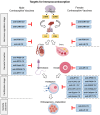Advances in Contraceptive Vaccine Development: A Comprehensive Review
- PMID: 40733669
- PMCID: PMC12299859
- DOI: 10.3390/vaccines13070692
Advances in Contraceptive Vaccine Development: A Comprehensive Review
Abstract
The issues of uncontrolled global population growth and unintended pregnancies are severe, and the existing contraceptive methods have numerous limitations, making the development of novel contraceptive technologies urgent. Contraceptive vaccines offer a promising alternative to traditional contraception methods. This article reviews the three developmental stages of contraceptive vaccines, including early exploration, technical bottlenecks, and innovative development directions in the new era. This article also summarizes the targets of immunocontraception, covering the current research status of contraceptive vaccines targeting sperm production, sperm antigens, oocyte zona pellucida, and gamete outcomes. Furthermore, this article explores the advantages of contraceptive vaccines in terms of efficiency, non-invasiveness, reversibility, and the promotion of gender equality. Challenges associated with clinical translation and real-world implementation are also critically analyzed.
Keywords: contraceptive vaccines; gamete outcomes; immunocontraception; sperm antigens; sperm production; zona pellucida of oocytes.
Conflict of interest statement
The authors declare no conflicts of interest. Figures were created by Figdraw (
Figures
Similar articles
-
Improving sperm selection strategies for assisted reproduction through closing the knowledge gap in sperm maturation mechanics.Hum Reprod Open. 2025 Jul 3;2025(3):hoaf040. doi: 10.1093/hropen/hoaf040. eCollection 2025. Hum Reprod Open. 2025. PMID: 40698010 Free PMC article. Review.
-
Immediate versus delayed postpartum insertion of contraceptive implant and IUD for contraception.Cochrane Database Syst Rev. 2022 Oct 27;10(10):CD011913. doi: 10.1002/14651858.CD011913.pub3. Cochrane Database Syst Rev. 2022. PMID: 36302159 Free PMC article.
-
Counseling in the clinical setting to prevent unintended pregnancy: an evidence-based research agenda.Contraception. 2003 Feb;67(2):115-32. doi: 10.1016/s0010-7824(02)00472-9. Contraception. 2003. PMID: 12586322
-
Inequality in modern contraceptive use and unmet need for contraception among women of reproductive age in Zambia. A trend and decomposition analysis 2007-2018.Reprod Health. 2024 Dec 9;21(1):181. doi: 10.1186/s12978-024-01909-8. Reprod Health. 2024. PMID: 39654062 Free PMC article.
-
Digital health technologies for accessing contraceptive services among young people in Sub-Saharan Africa: A scoping review protocol.PLOS Digit Health. 2025 Jul 10;4(7):e0000748. doi: 10.1371/journal.pdig.0000748. eCollection 2025 Jul. PLOS Digit Health. 2025. PMID: 40638690 Free PMC article.
References
-
- Umutesi V., Ogendi J. Family Planning Uptake and Associated Factors among Women of Reproductive Age in Rusizi District, Rwanda. J. Med. Nurs. Public Health. 2023;6:23–39. doi: 10.53819/81018102t4209. - DOI
-
- Bearak J., Popinchalk A., Ganatra B., Moller A.B., Tunçalp Ö., Beavin C., Kwok L., Alkema L. Unintended pregnancy and abortion by income, region, and the legal status of abortion: Estimates from a comprehensive model for 1990–2019. Lancet Glob. Health. 2020;8:e1152–e1161. doi: 10.1016/S2214-109X(20)30315-6. - DOI - PubMed
-
- World Health Organization . Trends in Maternal Mortality 2000 to 2020: Estimates by WHO, UNICEF, UNFPA, World Bank Group and UNDESA/Population Division. World Health Organization; Geneva, Switzerland: 2023.
Publication types
LinkOut - more resources
Full Text Sources


